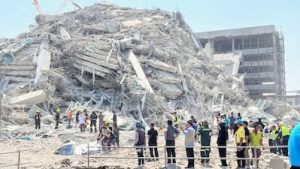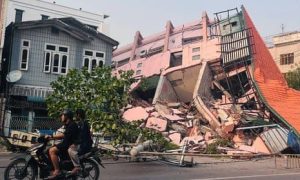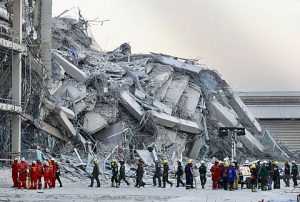A devastating 7.7-magnitude earthquake struck central Myanmar on March 28, 2025, causing catastrophic destruction and claiming thousands of lives. The tremors led to a unique structural collapse known as a “pancake” collapse, where buildings fall vertically on themselves. This has made rescue operations extremely difficult as teams struggle to reach survivors trapped under dense layers of debris.
Understanding Pancake Collapses and Their Impact on Rescue Efforts
A pancake collapse occurs when a building’s floors fail one after another, stacking up like pancakes. This type of structural failure creates dense and compacted debris, leaving almost no void spaces for survivors. Unlike tilted or partial collapses, where gaps might allow people to survive, pancake collapses make it extremely difficult for rescuers to find and extract survivors.
In cities like Mandalay and Sagaing, multiple buildings collapsed in this manner, forcing rescue teams to spend hours cutting through concrete slabs and steel reinforcements just to move forward a few feet. As time passes, the likelihood of finding survivors decreases, adding to the urgency of the rescue operations.
As of April 1, 2025, the official death toll has crossed 2,719, with more than 4,521 injured and at least 400 missing. The situation is dire, with the smell of decomposing bodies filling the air in Mandalay, as reported by local sources.

Aftershocks Add to the Crisis, Causing More Buildings to Collapse
Rescue operations have been further complicated by multiple aftershocks, the strongest of which struck on April 1 at 5:31 PM local time, measuring over 5.0 in magnitude. This aftershock caused at least six buildings, already weakened by the initial quake, to collapse entirely.
The fresh tremors triggered panic across Mandalay, forcing hundreds of displaced families to remain on the streets. Many are now living in makeshift camps, lacking proper food, water, medical supplies, and shelter. Survivors fear returning to their homes, as many structures are on the verge of collapse.
Rescue Efforts Face Major Obstacles
Rescue teams have been working tirelessly, but progress is slow due to the massive destruction and the nature of the collapses. Specialized equipment, including earth movers and high-powered saws, is being used to cut through the rubble, but it remains a time-consuming process.
To aid in the search for survivors, India has sent an 80-member National Disaster Response Force (NDRF) team to Myanmar. The team has brought with them four specially trained search-and-rescue dogs capable of detecting life signs under debris. These dogs are crucial in locating survivors in tightly compacted spaces caused by pancake collapses. However, the extent of the destruction and damaged infrastructure has slowed their efforts.


Severe Shortages of Food, Water, and Medical Supplies
The humanitarian situation in Myanmar is worsening as essential supplies run out. With thousands displaced, there is a severe shortage of clean drinking water, food, and medical aid. Hospitals are overwhelmed, and many injured people have nowhere to go for treatment. The United Nations has warned of potential disease outbreaks, as unsanitary conditions in temporary shelters could lead to infections and waterborne illnesses.
Communication and transportation networks have also been severely disrupted, further delaying relief efforts. Many roads are blocked due to collapsed buildings, making it difficult for aid and rescue teams to reach the worst-hit areas.
Ongoing Civil Unrest Hampers Relief Efforts
Adding to the crisis is Myanmar’s ongoing political instability and conflict. The country has been grappling with internal strife for years, and the military junta’s control has complicated international relief efforts. Reports suggest that some affected areas have been slow to receive aid due to government restrictions and logistical hurdles.
Despite these difficulties, local volunteers and international organizations continue to provide whatever help they can. Aid groups are calling for more international assistance, urging countries to send additional rescue teams, food supplies, and medical aid.


The Road to Recovery: What Lies Ahead for Myanmar
Myanmar faces a long and difficult road to recovery. The immediate focus remains on search-and-rescue operations to save as many lives as possible. However, once the rescue phase is over, the country will have to deal with massive rebuilding efforts, especially in cities like Mandalay and Sagaing, where entire neighborhoods have been flattened.
Experts predict that full recovery will take several years, given the extent of destruction and the country’s fragile political situation. International organizations, including the United Nations and Red Cross, are working on long-term plans to assist Myanmar in rebuilding homes, hospitals, and infrastructure.
Also Read : Kim Soo-hyun Denies Underage Relationship Allegations with Kim Sae-ron: A Closer Look at the Controversy
The Myanmar earthquake of 2025 has left behind immense destruction, with thousands of lives lost and many more still unaccounted for. The pancake collapses have significantly slowed down rescue efforts, making it harder to find survivors. Aftershocks, food shortages, and damaged infrastructure have only worsened the crisis, leaving thousands in desperate need of help.
As the world watches, humanitarian efforts continue, with both local and international aid workers striving to bring relief to those affected. The coming days will be critical in determining how many more lives can be saved, and how Myanmar will begin its long journey toward recovery.

